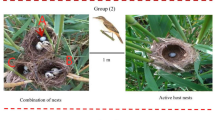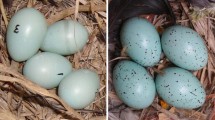Abstract
Chicks of many avian brood parasites evict their hosts’ eggs within 48 h of hatching. This behavior eliminates competition inside the nest and is beneficial for the fitness of the parasite. Several studies have proposed that this behavior is costly for the parasitic chick and may limit opportunities for cuckoos to exploit hosts with large clutch sizes. We tested whether increased eviction effort was associated with reduced growth in cuckoo chicks by artificially increasing the clutch size of superb fairy-wrens, the main host of the Horsfield’s bronze-cuckoo in Australia. Contrary to theoretical predictions, chicks that evicted a larger number of eggs did not lose mass. Instead, they had higher growth rates than chicks that evicted fewer eggs. This unexpected result suggests chicks might be able to use compensatory growth to overcome the costs of egg eviction, perhaps by increasing their begging rate after evicting more eggs. Our results, combined with previous evidence, suggest that brood parasites may not be constrained by the clutch size of their hosts, resulting in a broader set of potential hosts. Furthermore, laying larger clutches might not be an effective host defense against brood parasites.
Significance statement
Avian brood parasites lay their eggs in the nests of other species. Many parasitic chicks, like cuckoos, avoid competition inside the nest by evicting all the other eggs laid by the host. It is generally assumed that this innate behavior is costly for the cuckoo chick, and that evicting more eggs requires greater effort and higher physiological costs. In this study, we use the system of the superb fairy-wren and the Horsfield’s bronze-cuckoo in Australia to test whether evicting more eggs results in decreased growth in parasitic cuckoos. We found no evidence to suggest that evicting more eggs compromises growth in Horsfield’s bronze-cuckoos. In fact, chicks that evicted more eggs grew significantly faster than chicks that evicted fewer eggs, suggesting that chicks are able to compensate for the initial effort of evicting more eggs.


Similar content being viewed by others
References
Alonso-Alvarez C, Bertrand S, Faivre B, Sorci G (2007) Increased susceptibility to oxidative damage as a cost of accelerated somatic growth in zebra finches. Funct Ecol 21:873–879
Anderson MG, Moskat C, Ban M, Grim T, Cassey P, Hauber ME (2009) Egg eviction imposes a recoverable cost of virulence in chicks of a brood parasite. PLoS One 4:e7725
Bates D, Maechler M (2009) lme4: linear mixed-effects models using S4 classes. R package version 0. 999375–31, https://cran.r-project.org/web/packages/lme4/index.html
Brooker MG, Brooker LC (1989a) The comparative breeding behaviour of two sympatric cuckoos, Horsfield’s bronze-cuckoo Chrysococcyx basalis and the shining bronze-Cuckoo C. lucidus, in Western Australia: a new model for the evolution of egg morphology and host specificity in avian brood parasites. Ibis 131:528–547
Brooker MG, Brooker LC (1989b) Cuckoo hosts in Australia. Aust Zool Rev 2:1–67
Criscuolo F, Monaghan P, Nasir L, Metcalfe NB (2008) Early nutrition and phenotypic development: ‘catch-up’growth leads to elevated metabolic rate in adulthood. Proc R Soc Lond B 275:1565–1570
Davies NB (2000) Cuckoos, cowbirds and other cheats. T. & A.D. Poyser, London
Geltsch N, Hauber ME, Anderson MG, Bán M, Moskát C (2012) Competition with a host nestling for parental provisioning imposes recoverable costs on parasitic cuckoo chick’s growth. Behav Process 90:378–383
Grim T, Rutila J, Cassey P, Hauber ME (2009) Experimentally constrained virulence is costly for common cuckoo chicks. Ethology 115:14–22
Hargitai R, Costantini D, Moskát C, Bán M, Muriel J, Hauber ME (2012) Variation in plasma oxidative status and testosterone level in relation to egg-eviction effort and age of brood-parasitic common cuckoo nestlings. Condor 114:782–791
Kilner RM (2005) The evolution of virulence in brood parasites. Ornithol Sci 4:55–64
Kilner RM, Noble DG, Davies NB (1999) Signals of need in parent-offspring communication and their exploitation by the common cuckoo. Nature 397:667–672
Krause ET, Honarmand M, Naguib M (2011) Zebra finch nestlings beg more under better nutritional conditions. Behaviour 148:1239–1255
Langmore NE, Hunt S, Kilner RM (2003) Escalation of a coevolutionary arms race through host rejection of brood parasitic young. Nature 422:157–160
Martín-Gálvez D, Soler M, Soler JJ, Martín-Vivaldi M, Palomino JJ (2005) Food acquisition by common cuckoo chicks in rufous bush robin nests and the advantage of eviction behaviour. Anim Behav 70:1313–1321
Medina I, Langmore NE (2015) The costs of avian brood parasitism explain variation egg rejection behaviour in hosts. Biol Lett 11:20150296
Medina I, Langmore NE, Lanfear R, Kokko H (2017) The evolution of clutch size in hosts of avian brood parasites. Am Nat 190:E112–E123
Mulder RA (1992) Evolutionary ecology of the mating system of superb fairy-wrens. PhD thesis, Australian National University
Mulder RA, Dunn PO, Cockburn A, Lazenby-Cohen KA, Howell MJ (1994) Helpers liberate female fairy-wrens from constraints on extra-pair mate choice. Proc R Soc Lond B 255:223–229
Payne RB, Payne LL (eds) (1998) Parasitic birds and their hosts. Studies in Coevolution. Oxford University Press, Oxford
Rothstein SI, Robinson SK (1998) Parasitic birds and their hosts. In: Payne RB, Payne LL (eds) Studies in coevolution. Oxford University Press, Oxford, pp 59–212
Royle NJ, Hartley IR, Parker GA (2006) Consequences of biparental care for begging and growth in zebra finches, Taeniopygia guttata. Anim Behav 72:123–130
Spottiswoode CN, Koorevaar J (2012) A stab in the dark: chick killing by brood parasitic honeyguides. Biol Lett 8:241–244
Wilson P, Osbourn D (1960) Compensatory growth after undernutrition in mammals and birds. Biol Rev 35:324–361
Wright J, Markman S, Denney SM (2006) Facultative adjustment of pre-fledging mass loss by nestling swifts preparing for flight. Proc R Soc Lond B 273:1895–1900
Acknowledgments
We would like to thank the many volunteers that monitored nests at Serendip Sanctuary and Campbell Park, and Parks Victoria and their staff for supporting our research there. We would also like to thank two anonymous reviewers and the Editor Manuel Soler for comments on previous versions of this manuscript.
Funding
The authors received financial support from the Australian Research Council, DP150101652 and DP110103120 to RAM and DP110101966 to NEL.
Author information
Authors and Affiliations
Corresponding author
Ethics declarations
Ethical approval
All applicable international, national, and institutional guidelines for the use of animals were followed. This research was conducted under approval of the Australian National University Animal Ethics Committee Protocol Numbers F.BTZ.99.99 and A2012/47, and in Campbell Park, ACT Government License numbers LT1999021, LT2011509, LT2012589, LT2013667, LT2014776, and LT2015842. The research at Serendip was conducted with permits from the Department of Environment, Land, Water and Planning (10007530) and the University of Melbourne Animal Ethics Committee (1513677.2).
Conflict of interest
The authors declare that they have no conflict of interest.
Additional information
Communicated by M. Soler
Publisher’s note
Springer Nature remains neutral with regard to jurisdictional claims in published maps and institutional affiliations.
Electronic supplementary material
ESM 1
(XLSX 14 kb)
Rights and permissions
About this article
Cite this article
Medina, I., Hall, M.L., Taylor, C.J. et al. Experimental increase in eviction load does not impose a growth cost for cuckoo chicks. Behav Ecol Sociobiol 73, 44 (2019). https://doi.org/10.1007/s00265-019-2655-2
Received:
Revised:
Accepted:
Published:
DOI: https://doi.org/10.1007/s00265-019-2655-2




